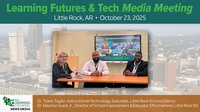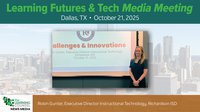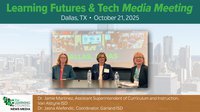Each fall, teachers will get a new sea of smiling faces in their classrooms. Almost no other industry operates under this unique business model, where each year your audience is replaced with a completely new one. And with that type of model in mind, it leads us to wonder what effect annual student influx has on technology adoption in the classroom and the cultural effect on the ability to experiment and personalize.
Meeting this year’s students “where they are” is going to look different than it did for last year’s class. And therein lies the challenge for both educators and EdTech leaders – how can we best serve an industry that’s constantly evolving every nine months?
No matter what your role in education is, we think it’s important to understand how the K-12 business model differs from other businesses and organizations, and what it requires to evolve alongside not only the education industry – but the classroom experience. Let’s explore what makes K-12 unique and how to best leverage technology to drive the experience.
Continuous Listening and Improvement
At the end of the year, educators and administrators come together to discuss what they’ll be doing and focusing on for the next year, and how that might be different than their previous strategy. On one hand, there's an opportunity to reset and make a plan to evolve for the better. But on the other, adding in a completely new mix of students you don't yet know becomes more challenging for both educators and EdTech leaders.
The cyclical nature of education allows for an annual review of what went well, what didn’t, how to augment the effort and what best practices were learned across the board should be shared – both in and out of the classroom. For teachers, this means evaluating one-on-one experience with the kids and examining what strategies and technologies are important to keep in the mix for next year, and which aren’t worth incorporating. This may be done on a more routine basis depending on the district, but at least once per year is standard across the board.
When you’re the company behind those classroom solutions that are either deemed essential or scrapable at the end of the year, it’s imperative to keep a finger on the pulse of those conversations districts are having on an annual basis. In the K-12 world, things are changing quickly and yearly. Don’t be the company that rests on its performance in the classroom from the year before. Teachers know they’ll be serving a new type of student next fall, and it’s important to be in the know as well.
Low Barrier to Entry
Another important aspect of the K-12 business model is how important it is for EdTech leaders to consider cost and how to create an offering that has a low barrier to entry for schools. Many teachers, especially those new to a district or grade, know all too well they might not have much data to lean on at the start of the school year. And while they may have last year’s performance, there’s a high chance they may not. Either way, the teacher will need assess how best to approach learning with their students on a group or individual level. Whether pedagogy-led or tool-driven approach, there are important decisions to be made and cost can make or break that choice.
Barrier to entry is critically important as a K-12 teacher or an EdTech company. The barrier needs to be as close to the floor as possible, meaning solutions need to basically unbox themselves. Schools need teacher-friendly technology and a great experience that feels perfectly thought out. From the moment an educator starts using a solution, your company needs to have anticipated every question and presented the answer for them. In the classroom, teachers need the ability to simply stop using technology one way and have the flexibility to pivot the solution in a direction benefitting their unique classroom’s needs. The solution needs to be nimble enough to quickly pivot not on an annual basis, but on a week-by-week to not only foster experimentation but allow teachers to course-correct what their kids need at an exact moment during a lesson.
Measuring Success
The next part comes when education leaders start looking at adoption. There are two ways teachers measure success today. The first is by their gut feeling – which is extremely important. What is the look on the kids’ faces? What is the engagement in the classroom? Does it feel like the class is sticking with the lesson and they're turned on to this learning technique, or not? All of these questions are asked during every lesson and can immensely impact what decisions teachers make during the annual review at the end of the year or the start of the new one.
The other is measurement. In other words, technology needs to present solutions teachers can use to collect data and create an analysis that's easy to understand. Teachers shouldn’t need advanced degrees in data analysis to definitively tell whether this solution is helping their kids learn. That responsibility is on the EdTech company to pull, parse out what is truly important, and make information easily digestible and quickly available to educators. From there, teachers can decide whether to continue down their current path with the technology or mix things up based on performance.
Understanding K-12 is Unique
Interactivity is critical to learning at all ages, from kindergarten to college. But in comparison to its counterparts in higher education, K-12 faces the challenge of extremely fast adoption and experimentation. In the higher ed business model, many classes are chosen by the students as part of their major. This means professors can spend a longer amount of time on certain subjects, dig deeper and anchor into specific topics. The way to engage young adults is much different than the strategy for K-12.
For starters, there's a greater number of subjects in K-12 that teachers are trying to push through in a smaller period. And though kids might learn faster than young adults, their attention spans are shorter. K-12 teachers need to hit higher levels of learning across a wide range of subjects every class and get kids interested in a large variety of subjects that are required of them to learn.
When you’re a teacher with a class that may or may not want to engage with the lesson, it’s imperative to find ways to pull the students in and edtech is a huge part of that effort. But regardless of their differences, technology and learning go hand in hand as kids and young adults prepare for an increasingly tech-driven world.
Trusting Education Will Follow the Market
Some people will say K-12 has a new “trend” every year. This year, it'll be Turnitin. Next year it will be flipping the classroom. The next year it will be something else. But evolving technology trends are actually a requirement because the kids change that quickly too.
For example, if you were to chart the performance of EdTech solutions in K-12, you would likely find educators are very tethered to one functional thing like quizzes. Introducing the ability to do digital quizzes, like Quizlet, is now immensely popular – but really within the last few years. Teachers have been doing quizzes forever, it's just the tool now exists to do it differently and more efficiently.
It's as simple as going back and looking at what are the top asks year-over-year in K-12 and evaluating whether they maintain their adoption. Some technologies will be adopted for a few years and decline. Others enter the market at warp speed and stay there – teachers will swear by them for a long period of time. As a company, the second category is where you really want to try to focus. You want to end up being the company that creates long-term value, not just something that's a flash in the pan of EdTech. And to do so, you need to build something that provides ongoing value to the educator and allows for customization to their goals for the classroom.
Best Practices for this Business Model
At the end of the year, when the annual class change is on the horizon, it’s important to consider just how different the K-12 business model is. There’s the opportunity to hit the pause button to dive into what’s been successful in the classroom, school or district. But the true key to success in this “business” is being aware of why it’s unique and how to best approach adding or subtracting new things to best serve the next group of students. Continuously listening to what teachers and students need is critical to evolving technology in the right direction, quickly followed by establishing a low barrier to entry and avenue to measure success. Fads will come and go, but to build or assimilate a product that will last the test of time is to create lasting value that will engage students for years to come.
About the Authors
Steve Halliwell is Chief Product Officer, Executive Vice President at Promethean. Prior to joining Promethean, Steve most recently held Executive Leadership roles at Amazon Web Services (AWS) since 2011. Steve started the Education and the Healthcare/Life Sciences verticals in addition to running the West Area commercial business. Prior to Amazon, Steve held progressive sales leadership roles in the technology sector with both Hewlett Packard and Microsoft.
Cheryl Miller is Chief Marketing Officer at Promethean. Cheryl has over 20 years in the tech industry and joined Promethean from Microsoft where she was the GM of the One Commercial Partner Team, leading the worldwide go-to-market efforts. Prior to Microsoft, Cheryl was VP of Marketing at F5 Networks and also spent 11 years at Symantec in various product teams including four years leading the Huawei Symantec Joint Venture program office and investment.











